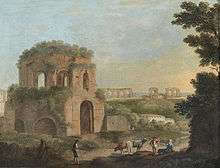Temple of Minerva Medica (nymphaeum)
- For the non-extant temple on the Esquiline mentioned in ancient Roman sources, see Temple of Minerva Medica.

The erroneously named Temple of Minerva Medica is, in fact, a ruined nymphaeum of Imperial Rome, lying between the via Labicana and Aurelian Walls and just inside the line of the Anio Vetus.[1] Once part of the Horti Liciniani on the Esquiline Hill, it now faces the modern Via Giolitti. At one time, it was thought to be the temple to Minerva Medica ("Minerva the Doctor") mentioned by Cicero and other sources. In fact it is a nymphaeum, a building devoted to the nymphs and often connected to the water supply, that dates to the 4th century. The decagonal structure in opus latericium is relatively well preserved, the full dome having collapsed only in 1828. It is surrounded on three sides with other chambers added at a later date. There is no mention of it in ancient literature or inscriptions.
The structure represents a transition in Roman secular architecture between the octagonal dining room of the Domus Aurea and the dome of the Pantheon, in particular, and the architecture of nearby Byzantine churches. The diameter of the hall is about 24 metres, and the height was 33 — important from the structural point of view, especially for the ribs in the dome. In the interior are nine niches, besides the entrance; and above these are ten corresponding round-arched windows. Both the interior and exterior walls were once covered with marble.[2]
In Flavio Biondo's 15th-century Roma Instaurata, these ruins are called Le Galluzze, a name of uncertain meaning that had been applied earlier to some ruins near the basilica of Santa Croce in Gerusalemme.[3] Its misidentification as the Republican-era temple dates to the 17th century, based on the erroneous impression that the Athena Giustiniani had been found there.[4]
See also
References
- ↑ John Henry Parker (1876). The Archaeology of Rome: The Aqueducts. J. Parker and Company. pp. 98–.
- ↑ Durm, figs. 306‑308, 313, 339; Choisy, pl. X. i. pp82‑84; Sangallo, Barb. 12; Giovannoni in Ann. d. Società d. Ingegneri, 1904, 165‑201; LS III.158‑161; JRS 1919, 176, 182; RA 182‑188; cf. HJ 360, n44, for references to other illustrations and plans)
- ↑ Jord. II.130‑131.
- ↑ HJ 360; LS III.158‑161.
External links
| Wikimedia Commons has media related to Temple of Minerva Medica (Rome). |
- Nymphaeum
- Description in the site of the "Soprintendenza Speciale per il Colosseo, il MNR e l'Area Archeologica di Roma.
Coordinates: 41°53′38″N 12°30′43″E / 41.89389°N 12.51194°E